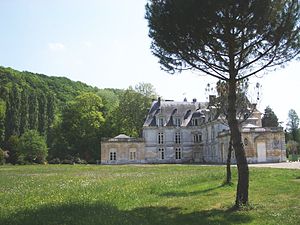Acquigny
| Acquigny | ||
|---|---|---|

|
|
|
| region | Normandy | |
| Department | Your | |
| Arrondissement | Les Andelys | |
| Canton | Pont-de-l'Arche | |
| Community association | His-yours | |
| Coordinates | 49 ° 10 ′ N , 1 ° 11 ′ E | |
| height | 14-143 m | |
| surface | 17.83 km 2 | |
| Residents | 1,586 (January 1, 2017) | |
| Population density | 89 inhabitants / km 2 | |
| Post Code | 27400 | |
| INSEE code | 27003 | |
| Website | http://www.acquigny.fr/ | |
 Acquigny Castle |
||
Acquigny is a commune with 1,586 inhabitants (at January 1, 2017) in the Eure in the region of Normandy ; it belongs to the arrondissement of Les Andelys and the canton of Pont-de-l'Arche .
geography
Acquigny is located in the Lieuvin countryside , 82 kilometers southeast of Le Havre and five kilometers southeast of Louviers at an average altitude of 79 meters above sea level . The Mairie stands at a height of 20 meters. The village is surrounded by the neighboring communities of Pinterville , Vironvay , Heudreville-sur-Eure , and Amfreville-sur-Iton . The municipality has an area of 1783 hectares. The rivers Eure and Iton and the stream Les Courtieux flow through the municipality.
Acquigny is assigned to a climate zone of type Cfb (according to Köppen and Geiger ): warm, moderate rainy climate (C), fully humid (f), warmest month below 22 ° C, at least four months above 10 ° C (b). There is a maritime climate with a moderate summer.
history
On aerial photographs from the 1990s can be a network of roads from Gallo-Roman times (55 v. Chr. To 486 n. Chr.) Visible. One road led to Val-de-Reuil , another via Les Andelys to Fleury-sur-Andelle . In 1856 some Roman coins were found during the destruction of the old bridge near the palace park. 1863 Roman coins were found in a brick well in 1908. They are Antoniniane from the reign of Valerian (253-260) to Constantius I Caesar (293-305) and Galerius Caesar (293-305). Traces of an underground aqueduct have been found near the manor house , which carried water from the Becdal stream towards Louviers.
It is believed that a chapel in honor of the martyr Maximus of Évreux and his deacon Venerandus was first built in the 5th century. Roger I. de Tosny donated the chapel and lands to the monastery of Saint-Pierre et Saint-Paul in Conches-en-Ouche in 1035 . Which then founded a priory in Acquigny. In the Hundred Years War (1337-1453) the priory was destroyed and from 1450 rebuilt. From 1752 only the chapel existed.
Population development
| year | 1962 | 1968 | 1975 | 1982 | 1990 | 1999 | 2008 | 2016 |
| Residents | 961 | 975 | 1006 | 1055 | 1292 | 1448 | 1611 | 1531 |
Attractions
In the Saint-Mauxe-Saint-Vénérand chapel, there is a stained glass window from the 13th and mid-15th centuries that glorifies the Virgin Mary . It depicts Mary with her attributes crescent moon, lily, with the child as free from original sin, although it was made before the bull Grave nimis of Pope Sixtus IV . The chapel used to be the abbey church of the Saint-Mauxe-et-Saint-Vénérand priory. It was entered in the supplementary directory of the Monuments historiques in 1954 and thus placed under monument protection.
- Acquigny Castle (built from 1557)
- Church of Sainte-Cécile (choir built from 1545)
- Former prison (14th to 16th centuries)
economy
Protected Geographical Indications (IGP) apply to pork (Porc de Normandie) , poultry (Volailles de Normandie) and cider (Cidre de Normandie and Cidre normand) in the municipality .
literature
- Pierre-François Lebeurier: Acquigny. Notice sur la commune avant 1790. 1862. Online on Gallica . (Facsimile: Res Universis, Paris 1992, ISBN 2-7428-0014-X )
Web links
Individual evidence
- ↑ a b Le village d'Acquigny. In: Annuaire-Mairie.fr. Retrieved July 6, 2012 (French).
- ^ Jean-Noël Le Borgne, Véronique Le Borgne, Pascale Eudier, Annie Etienne: Archeologie Aérienne dans l'Eure . Ed .: Association Archéo 27. Page de Garde, Caudebec-les-Elbeuf 2002, ISBN 2-84340-230-1 , p. 46 .
- ^ Dominique Cliquet: L'Eure . 27. In: Michel Provost, Academie des inscriptions et belles-lettres, Ministere de la culture (ed.): Carte Archéologique de la Gaule . Fondation Maison des Sciences de l'Homme, Paris 1993, ISBN 2-87754-018-9 , chap. 197 , p. 190 f . (French).
- ↑ a b Entry No. 27003 in the Base Mérimée of the French Ministry of Culture (French)
- ↑ Laurence Riviale: Le vitrail en Normandie entre Renaissance et Réforme (1517–1596) . In: Corpus Vitrearum . tape 7 . Presses Universitaires de Rennes, Rennes 2007, ISBN 978-2-7535-0525-4 , pp. 131-133 (French).

